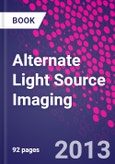Alternate Light Source Imaging provides a brief guide to digital imaging using reflected infrared and ultraviolet radiation for crime scene photographers. Clear and concise instruction illustrates how to accomplish good photographs in a variety of forensic situations. It demonstrates how tunable wavelength light sources and digital imaging techniques can be used to successfully locate and document physical evidence at the crime scene, in the morgue, or in the laboratory. The scientific principles that make this type of photography possible are described, followed by the basic steps that can be utilized to capture high quality evidentiary photographs.
About the Forensic Studies for Criminal Justice Series: The Forensic Studies for Criminal Justice series consists of short-format content on new developments, unique perspectives, or how-to information on areas in forensic science-all specifically designed to meet the needs of the criminal justice community. Instructors wishing to provide their students with more in-depth coverage on certain forensic areas can add these digestible, inexpensive works to their syllabi without having to completely redesign their course, introduce overly complex material, or financially overburden their students. Law enforcement and other criminal justice professionals will find a wealth of valuable information to improve training sessions. Written by experts in the disciplines they are covering and edited by a senior scholar in criminal justice, Forensic Studies for Criminal Justice opens up the world of forensic science to the criminal justice community.
- Part of a new Anderson series presenting brief works on forensic science, written especially for students and law enforcement
- Clear, concise instruction on the fundamentals of alternate light source imaging
- Covers a variety of crime scene situations
- Full-color images
About the Forensic Studies for Criminal Justice Series: The Forensic Studies for Criminal Justice series consists of short-format content on new developments, unique perspectives, or how-to information on areas in forensic science-all specifically designed to meet the needs of the criminal justice community. Instructors wishing to provide their students with more in-depth coverage on certain forensic areas can add these digestible, inexpensive works to their syllabi without having to completely redesign their course, introduce overly complex material, or financially overburden their students. Law enforcement and other criminal justice professionals will find a wealth of valuable information to improve training sessions. Written by experts in the disciplines they are covering and edited by a senior scholar in criminal justice, Forensic Studies for Criminal Justice opens up the world of forensic science to the criminal justice community.
- Part of a new Anderson series presenting brief works on forensic science, written especially for students and law enforcement
- Clear, concise instruction on the fundamentals of alternate light source imaging
- Covers a variety of crime scene situations
- Full-color images
Table of Contents
Understanding Electromagnetic RadiationTunable Wavelength Light Sources
Photographic Equipment
Photography with UV and Forensic Light Sources
Infrared Photography
Authors
Marin, NormanNorman Marin worked for the NYC Office of the Chief Medical Examiner from 2001-2012, where he began with DNA extraction and quantification before transferring to the Special Investigation Unit, where he worked on crime reconstruction issues involving bloodstain pattern analysis, bullet trajectory, evidence examinations, forensic photography, and the identification of latent blood through chemical enhancements. A graduate of the John Jay College, Marin now teaches at Pace University at the Dyson College of Arts and Sciences, Forensic Science program, where he teaches digital photography, among other forensic disciplines.
Buszka, Jeffrey M.
Jeffery M. Buszka holds a Master's of Science Degree in Forensic Science from John Jay College of Criminal Justice where was also an Adjunct for 6 years in the Forensic Science program. Mr. Buszka is also a board certified as a Diplomate by the American Board of Criminalistics. For 7 years he worked as a Criminalist in the NYC Office of Chief Medical Examiner - Forensic Analysis and Reconstruction Unit. The main responsibilities of the Unit included the examination of physical evidence for the purposes of crime scene and incident reconstructions. Prior to the OCME he worked at the Yonkers Police Department Forensic Science Laboratory where his duties included drug chemistry, latent fingerprint development, serial number restoration, footwear identification and forensic photography.








